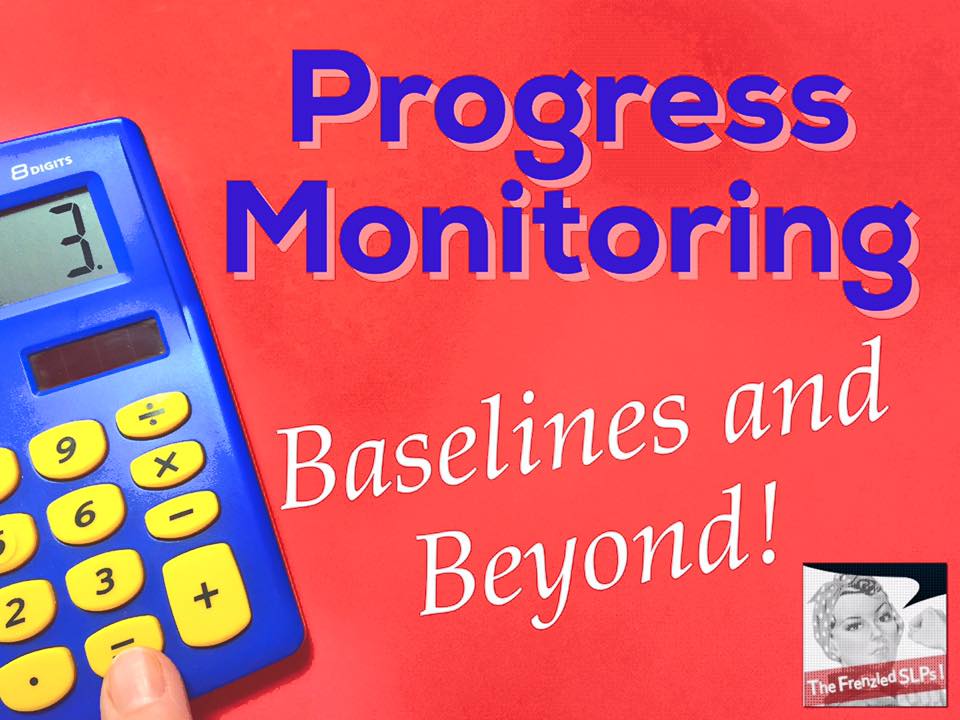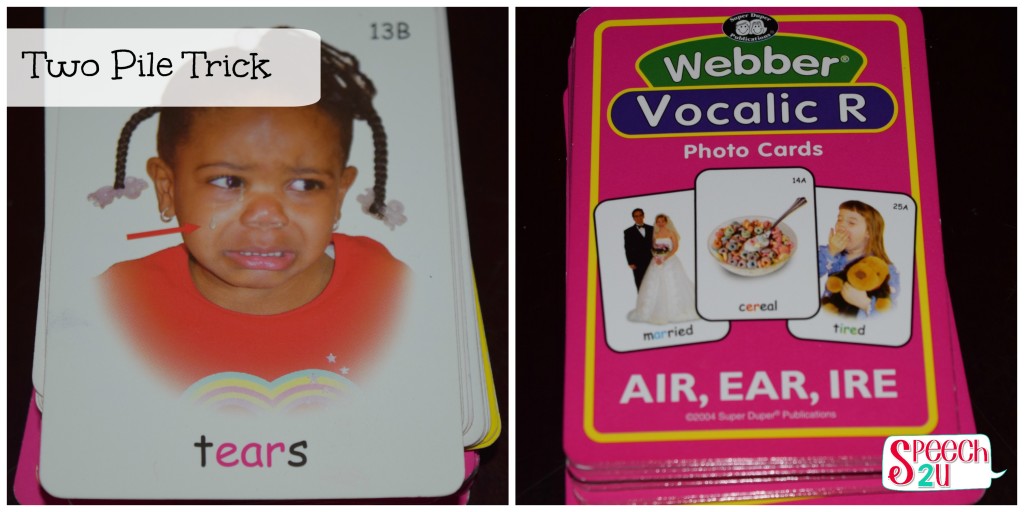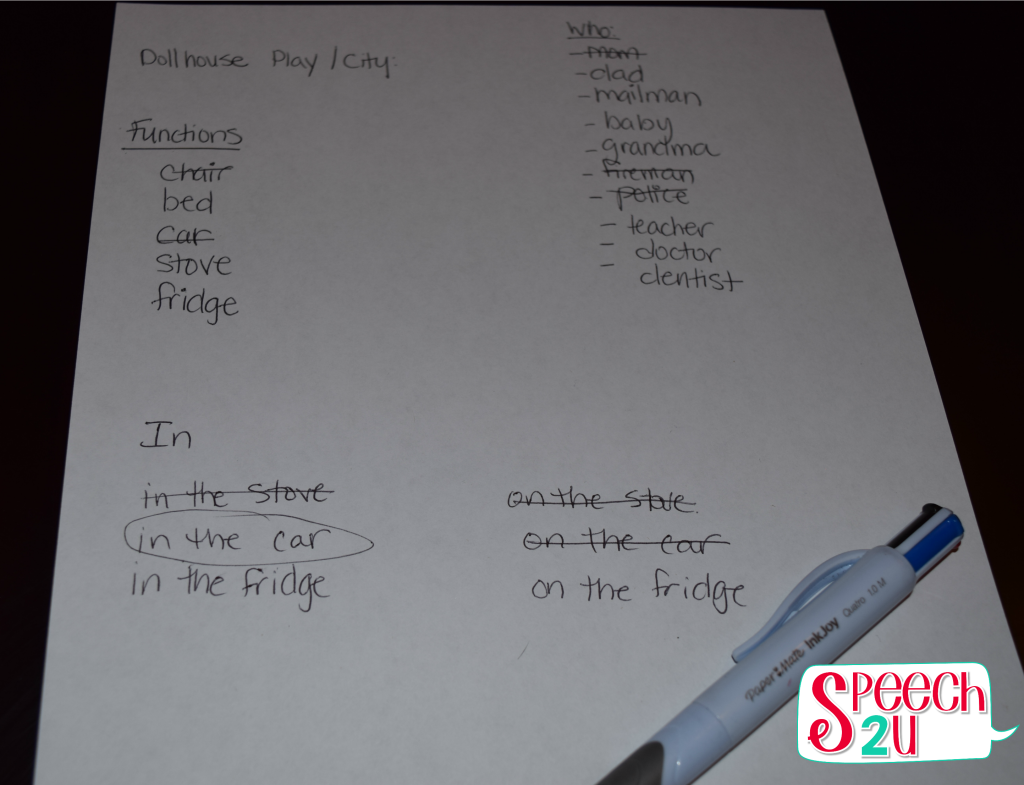I’m have to share a story of when I was doing an observation of another therapist. I was intently watching and writing down some notes so I could give some good feedback. When I got done, I realized that I had also been making hash and sidewise hashmarks. Data collection is something that has been ingrained in me my whole career.
Today I’m linking up with the Frenzied SLPs to talk about data collection and progress reporting. This is one of my favorite link ups because I get so many great ideas for how I can track progress for my clients and students.

The biggest challenge for me is managing data collection/progress reporting with the actual teaching of skills. When I am too focused on the data, it makes it more difficult (sometimes) for me to think about the cues that I am using and how I am going to adjust my therapy for the best results during that session.
Here are four techniques that I’ve used over the years
Data collection using sets of ten:
I pretty much do all of my data collection in a set of 10. For example, I might take a set of 10 picture cards that I am going to use at the end of the session within a fun game. I’m modeling and working on the skills throughout the clients session-fading and adjusting cues. Check out my series on the understanding the cues and prompts you use by clicking HERE.
During the last five minutes, I can pull out my picture cards or other stimuli and do a quick assessment of progress. The bonus of working in a set of ten is that it makes the math REALLY easy to do. For articulation, I might have the child say a specific word or set of 10 words as we are walking back to their classroom.
Data collection with the old two pile trick:

If you have students who need monitoring, it can be tricky to take data. I use my computer for most data collection now, but I have some students who will try to type on the computer. Often frantically-undoubtably because that is what I model at the end of every session, when I am writing my note. If I wait until later, I’ve already forgotten most of what we did.
For them, I use a set of two piles: the correct/incorrect pile. At the end of the session, I can quickly total up the number of correct answers-especially if I used the set of ten rule. Here are a few “two pile” games.
- Correct are face up, incorrect face down
- Correct in the bucket, incorrect outside of the bucket
- Correct in the mailbox, incorrect in the mailbag
- Correct in my front pocket, incorrect in my back pocket
I think you get the picture. I also use this technique with clients or students who are sensitive to hashmarks, tend to have a fixed vs. growth mindset or I don’t trust around sharp objects like pencil points. Understanding how you are doing in therapy is important for self monitoring and improved progress, but I’ve found that not every client is able to handle that information.
Play based data collection:

I saw this technique while observing an awesome therapist. It takes more time, but it helps me stay focused when we are playing in therapy as well as being able to track my younger client’s progress. Here is how you do it:
- Write out the targets you want to address/model within your therapy session. For example, you may be working on answer what do questions, identifying objects by function, following directions containing prepositions etc.
- As you are doing therapy, cross items off if the client is successful. Circle items you want to continue to work on.
- You may want to choose a certain number of times that you want the client to answer/identify a target prior to moving on. For me that is usually 2-3 sessions in a row.
- Once they have met the targets, you can complete a generalization probe or add more targets within that goal.
Generalization probes:
Of course the difficulty with structured sessions is that sometimes we are teaching individual responses-when we really want the client to be able to generalize. With articulation, syntax, comprehension etc., it’s also important to take time to check for generalization of skills.
Here’s how I do it:
- Create two sets of cards or therapy targets, one that you will teach/cue and one you will use for assessment.
- Choose a specific time when you will monitor progress. This may be once a month, or before progress reports.
- Teach and cue the first set of cards/therapy targets. Take data on the set you are teaching as needed and record your cues.
- Check for generalization of skills using your second set of cards at the designated time.
QUESTION: Do you struggle with data collection or progress monitoring? What strategies have you used to help?
You can write your answers in the comments below OR share your ideas by linking up with the Frenzied SLPs. Make sure to comment on the two posts before and after yours.
P.S. Did you find this post helpful? I’d love it if you could help spread the word by sharing on FB or pinning this post!
 Loading InLinkz ...
Loading InLinkz ...

I’m a 10 question gal too! Thanks so much for this fantastic post. It’s full of helpful ideas and useful information!! 🙂 Manda
I think they are a lot of us! Thanks for stopping by!
I love the tip about writing targets before the session!
Thanks!
Fantastic suggestions…every one! Thank you for sharing your expertise.
Thank you!
I use something similar to the play-based tool you’ve described. Great point about checking for generalization!
I do the 2 pile trick a lot with my preschoolers…too much going on to take data on paper!
Love your rule of 10. I do the same thing. Maybe it is because I am terrible at percentages!
I love how specific and easy to implement your ideas are! I use quite a few of them myself and they really work! Love this post- all new SLPs should read it!
When I learned the sets of 10 trick, it was life changing:)! Love your generalization probes and suggestions. Definitely need to start incorporating this into therapy!